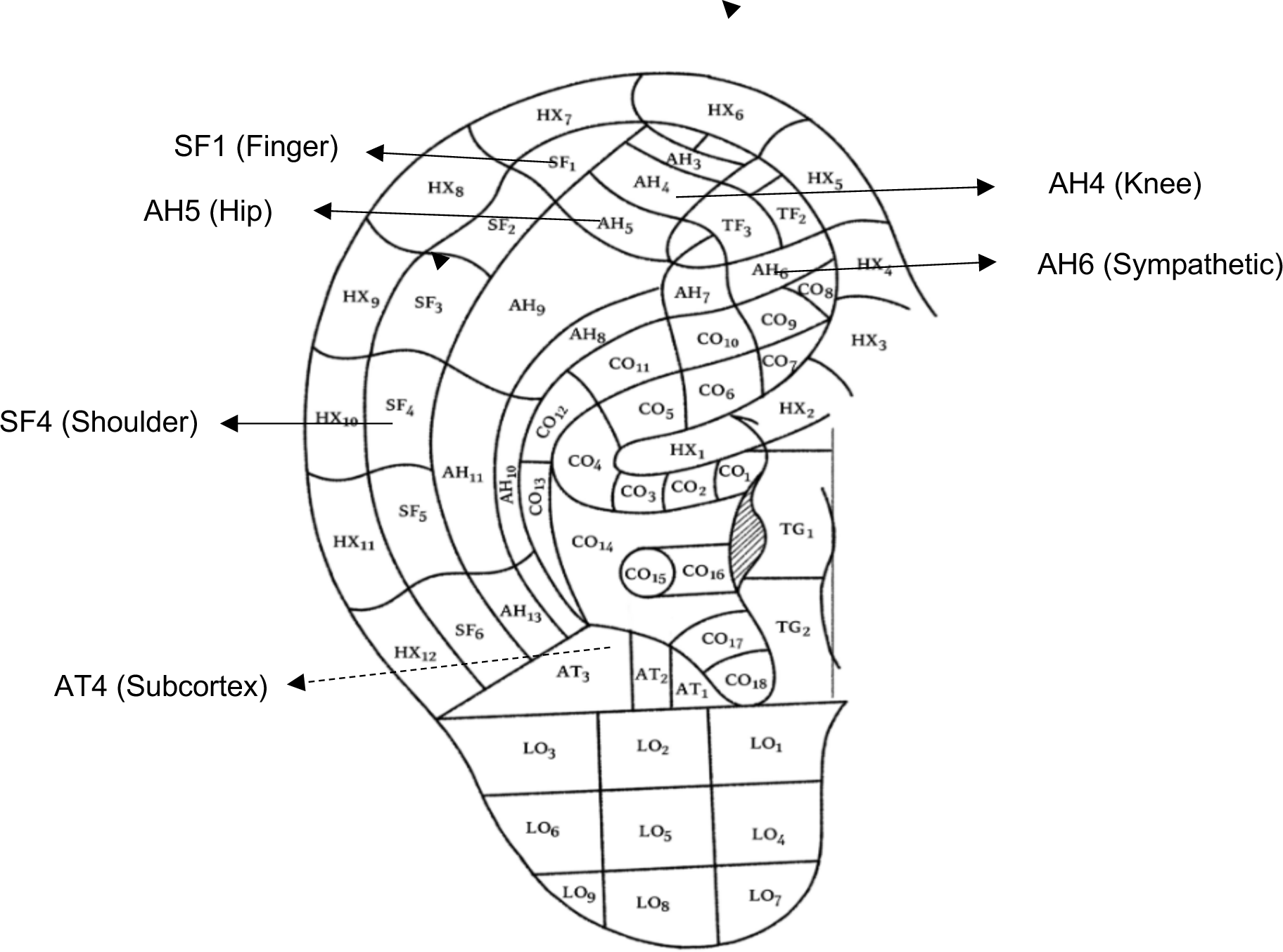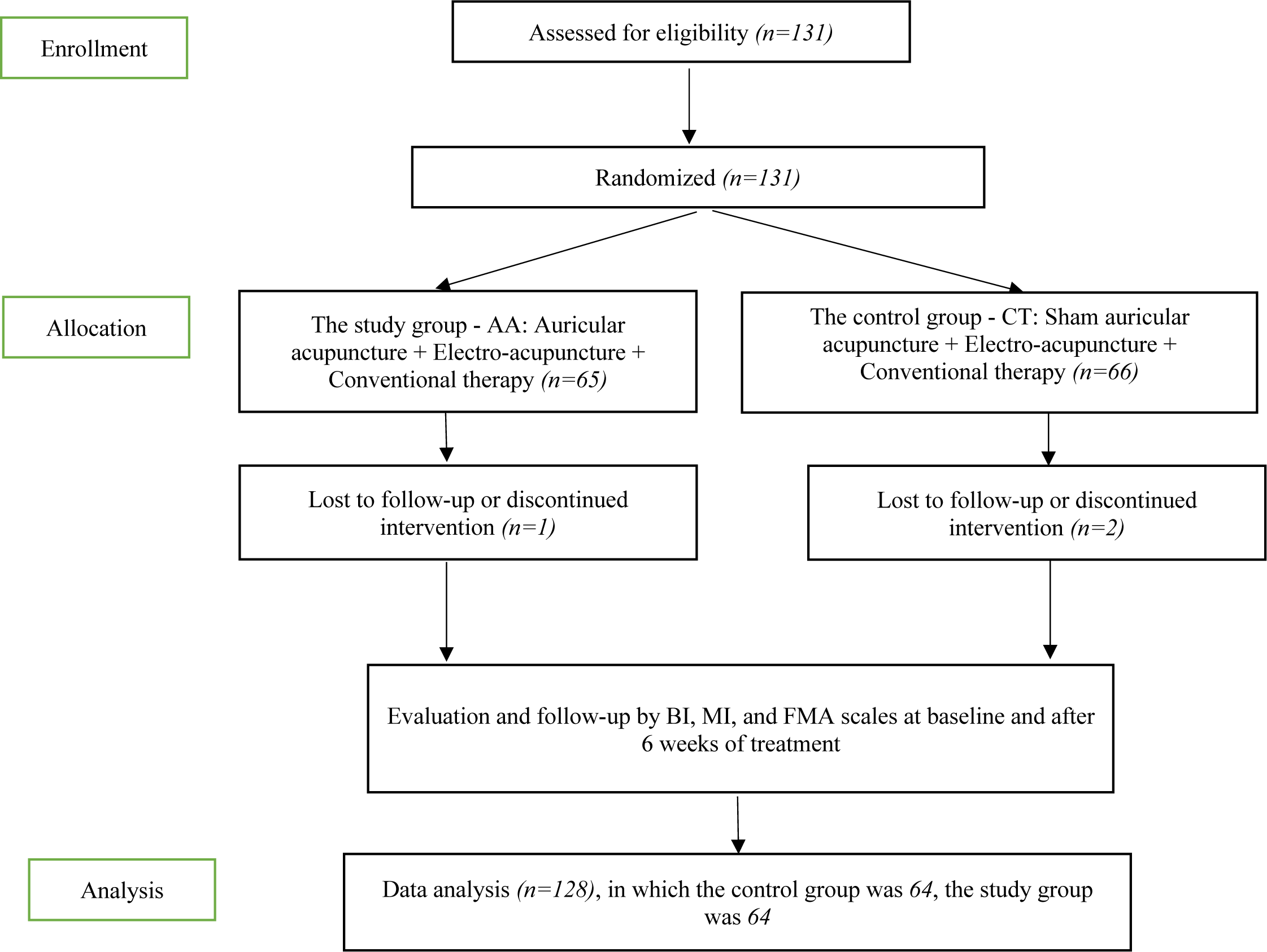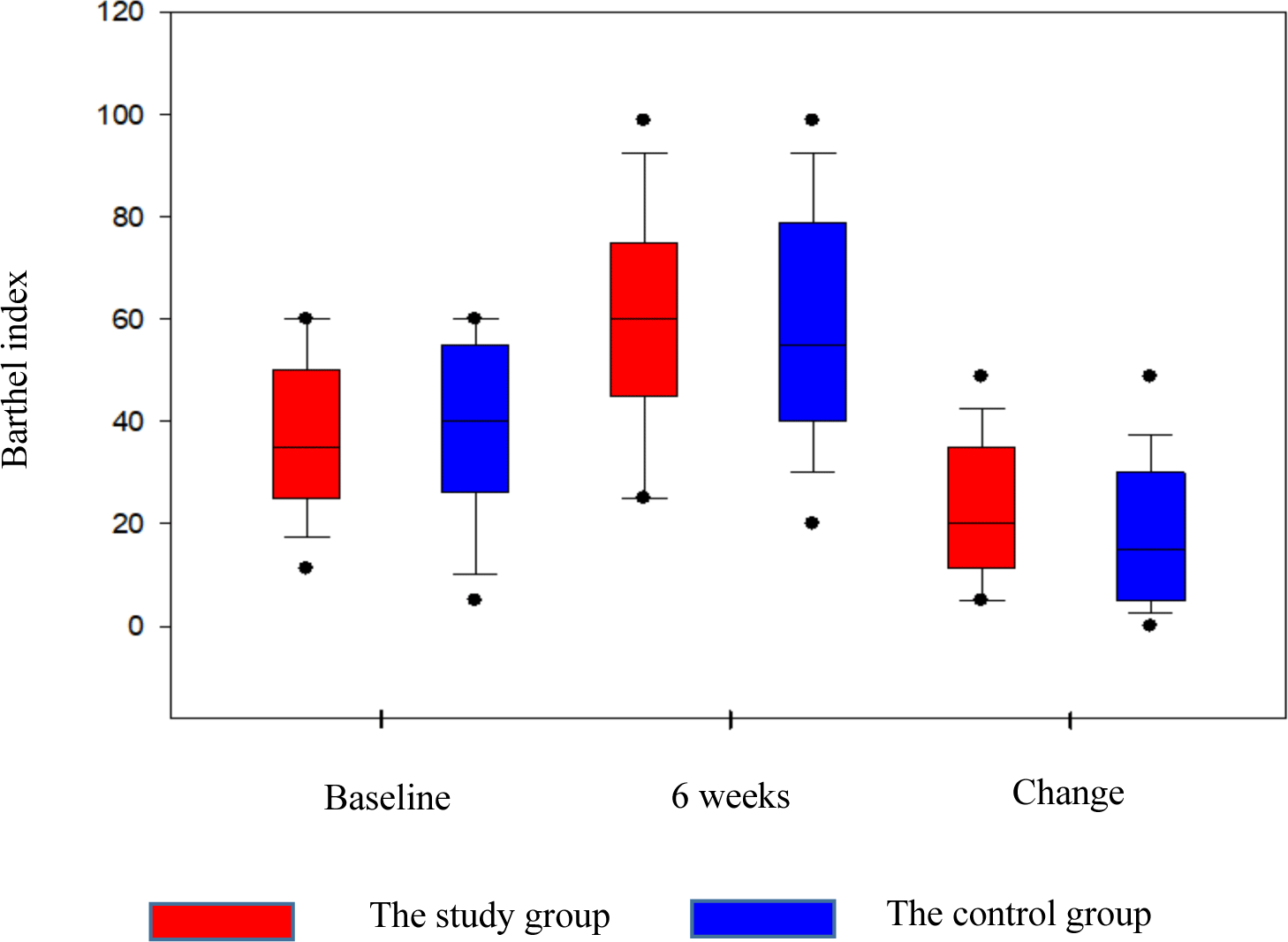1. INTRODUCTION
Stroke is a leading cause of disability and death globally [1]. Annually, 795.000 people in the USA (United States) suffer a stroke, and nearly a quarter have had a previous stroke [2]. In Europe in 2017, there were 1.12 million strokes, which will increase, estimated at 27% after 30 years from 2017 to 2047 [3]. Ischemic and hemorrhagic strokes are the main types of stroke, ischemic stroke accounts for the majority, with a rate from 62.4% to 87% [4]. Stroke is a health problem with severe consequences, affecting economies and quality of life, which burdens survivors, their families, and even society. In particular, 15-30% of stroke patients are disabled and entirely dependent, and 40-50% are partially dependent [5]. Vietnam is one of the countries with a very high rate of new strokes, falling from over 218.3 per 100.000 people [4]. The acute or recovery phase of stroke consumes many healthcare costs [7]. If we count disability-adjusted life years lost (DALYs), we lost about 113 million DALYs in 2013 in the burden of stroke [8]. Thus, motor rehabilitation after stroke is one of the urgent issues to help patients integrate into the community, reducing the burden on their families and society. Helping stroke patients recover effectively requires a multimodal treatment, including many different approaches, especially methods that combine modern medicine (i.e., basic clinical medications, physiotherapy exercise) and traditional medicine (i.e., electro-acupuncture).
Recent studies show that stimulation of the X nerve (Vagus Nerve Stimulation-VNS) also contributes to improving motor function after stroke [9], [10], [11]. Trans-auricular vagus nerve stimulation (taVNS), a non-invasive alternative therapy, has benefits similar to invasive VNS in enhancing the effects of physiotherapy on motor recovery [12]. This result suggests that direct stimulation of the craniofacial neural pathway can be effective in post-stroke rehabilitation, especially the stimulation of the brain stem nuclei involved in motor control function. Many studies have demonstrated the clinical effectiveness of craniofacial micro-acupuncture techniques in hemiplegia cases (e.g., scalp acupuncture [13], [14], auricular acupuncture [15]). Auricular acupuncture is a unique and longstanding Traditional Medicine treatment, which has a similar impact to X-nerve stimulation therapy (VNS) [15], [16], so it may be of value in restoring motor function after stroke as a complementary method to acupuncture and physiotherapy. Therefore, this RCT study (randomized controlled trial) evaluated the effectiveness of auricular acupuncture combined with physiotherapy exercise and electro-acupuncture in motor rehabilitation after an ischemic stroke.
2. MATERIALS AND METHOD
This randomized double-blind controlled clinical trial - RCT study was conducted on 128 patients with hemiplegia after ischemic stroke who were treated at three hospitals in Ho Chi Minh City – HCMC (HCMC Hospital of Traditional Medicine, University of Medical Center HCMC - Branch no.3 and HCMC Hospital for Rehabilitation and Professional Diseases) from February 2021 to January 2023. Participants were randomly allocated to either (a) the study group - AA (auricular acupuncture combined with electro-acupuncture and conventional therapy) or (b) the control group - CT (sham auricular acupuncture combined with electro-acupuncture and conventional therapy). Randomization was done by a health practitioner not involved in patient recruitment, intervention, and assessment, using a computer-based random number to generate a random and unpredictable allocation sequence. The purpose of the study and the elements of informed consent were fully explained to the participants, then they all signed the consent form. The assessments of treatment efficacy were performed by physicians who were blind to the treatment methods during the study period.
Formula to calculate sample size:
The significance level is α=0.05, β=0.10. The sample size formula for comparing the means of two groups, using the research result of Ru-Lan Hsieh that the FMA score increased by 27.4 ± 12.9 compared to before treatment [17]. Our study expected that the post-treatment FMA score of the AA could increase by 30% compared to the CT. Based on the above formula, with r = 1, n1 or n2 is the acceptable sample size for each group; a, we get n1 = n2 = 52. Between subjects can occur the probability of absence from follow-up and termination for many different reasons. Thus, allowing consumption from 10% should adjust the sample size for each group to 58 patients; the total of the two groups is 116. During the study period, we collected 128 samples.
A physician interviewed and evaluated participants, while another subsequently assessed the efficacy of treatment methods. Inclusion Criteria: All people who met all of the following criteria: (1) diagnosis of ischemic stroke (based on standard criteria of Ministry of Health, or by medical record); (2) hemiplegia after stroke (3) aged 18 years or more; (4) stay awake, cooperate with the treating physician; (5) Barthel index ≤ 60; (6) within the early recovery period from 24 hours to 3 months post-stroke. Exclusion Criteria: People were excluded if they met one or more of the exclusion criteria: (1) hemorrhagic stroke, (2) too exhausted or much inflammation; (3) malignant tumors or infectious diseases, (4) received auricular acupuncture before, (5) having a pacemaker. Withdrawal from the study: (1) The onset of unpleasant symptoms occurred at any stage during the study period; (2) Participants could withdraw consent from study participation at any time.
Physiotherapy practice of the Bobath approach. Bobath approach works on the different types of movement dysfunctions and is based on the active involvement of the patients so that they can develop motor control. Bobath’s principle and technique is to restore and relearn normal movement patterns before nerve damage, eliminate abnormal motor patterns using reflex inhibition techniques, helping patients relearn the sensation of movement rather than strengthening muscles. The motor movements on the paralyzed side are focused on creating stimulation, which is conducted along afferent pathways to the injured hemisphere. These stimuli have the effect of restoring the inherent movement patterns [18]. Before exercise, the patient’s vitals are measured; if the blood pressure is > 140/90 mmHg, stop exercising that day. These patients were asked to practice for about 45-60 minutes per day, and received five sessions per week, over six consecutive weeks of the follow-up period. Besides, all participants received the conventional therapy, including basic clinical medications selected on the basis of the “Guidelines for diagnosis, treatment, and rehabilitation of post-stroke patients according to Ministry of Health (2018)”[5].
All participants received EA treatment at the acupoints of Yangming channels on the paralyzed limb, including LI-15 (Jianyu), LI-14 (Binao), LI-11 (Quchi), LI-10 (Shousanli), LI-7 (Wenliu), LI-6 (Pianli), LI-5 (Yangxi), LI4 (Hegu), ST-34 (Liangqiu), ST36 (Zusanli), ST-40 (Fenglong), ST-41 (Jiexi). The study using EA had a set frequency of 6–20 Hz and a current intensity of 2–10 mA for 20-30 minutes daily and received five sessions per week over six consecutive weeks of the follow-up period.
Acupoints: According to the terminology and location of the ear acupoints of WHO, this study used six auricular acupoints, including AT4 (Subcortex), AH6 (Sympathetic), SF4 (Shoulder), SF1 (Finger), AH5 (Hip), AH4 (Knee); see Figure 1 [19].
Procedure: The patient sat and rested for 10 minutes, and the skin of acupoints was disinfected with 70% ethyl alcohol. The AA group received auricular acupuncture with Khanh Phong press needles, size 0.25 * 1.3mm, the Ministry of Health - Administration of Traditional Medicines and Medicines licensed circulation according to Official Letter No. 287/BYT-YDCT, dated January 18, 2019. The CT group received sham auricular acupuncture with an adhesive patch without needles (the acupoint formula was similar to that of the AA group). These needles or patches were retained on acupoints once every five days per week throughout six consecutive weeks of the follow-up period.
The first assessment was performed immediately after the consent of the eligible participants. Clinical outcomes were assessed and measured at two-time points, including before and six weeks after the initiation of the intervention. Before conducting this research, evaluators were trained to use three scales for assessment, then their comprehension of the rating scales was confirmed.
To comprehensively assess outcome measures, including disability, and motor functioning impairment, we used the Barthel Index, Motricity Index, and Fugl-Meyer Assessment scales. The FMA was used in this study to assess motor function in post-stroke patients. In particular, FMA can help practitioners evaluate the coordination, motor function, and reflex action of the lower extremity - LE (the hip, knee, and ankle) with a 17-item subscale and upper extremity - UE (shoulder, elbow, forearm, wrist, and hand) with 33-item subscale. A 3-point scale, ranging from 0 to 2 (cannot perform to perform fully), is used to assess these items. The motor score ranges from 0 to 100 points which are divided into 66 points (UE) and 34 points (LE) [20]. The BI is the measure assessing independence in activities of daily living: eating, bladder and bowel control, using the restroom, dressing and undressing, transitioning from wheelchair to bed and vice versa, mobility in a wheelchair, walking on flat surfaces, getting on or going down the stair. The scale varies from 0 (total dependence) to a maximum of 100 points (complete independence) in the assessed dimensions [21]. The Motricity Index (MI) measures upper and lower extremity muscle strength. Movements for upper extremities: elbow flexion, shoulder abduction, pinch grip. Moves for lower extremities: knee extension, ankle dorsiflexion, and hip flexion. The score for pinch grip is 0 (No movement), 11 (Starting to grasp), 19 (Can grasp the cube but cannot hold it under the influence of gravity, the operator must raise the wrist), 22 (Can grasp and hold a cube under the force of gravity), 26 (Can grasp and hold a cube, overcome a slight pull, but still weaker than the opposite side), 33 (Normal muscle strength). Scores for the remaining actions are 0 (No movement), 9 (Feel muscle contraction, but cannot move), 14 (Movement cannot reach the full range of motion - ROM and cannot overcome gravity), 19 (Full range of motion and overcome gravity, but not resistance), 25 (Full ROM, overcome gravity but less strong than the other side), 33 (Normal muscle strength). The maximum score of the upper and lower limbs is 99 (scale from 0-99), with higher scores indicating better mobility [22], [23].
Evaluate the adverse events during the study period, including pain at insertion, skin pigmentation, pallor, vertigo, nausea, and fainting.
This study used SPSS 22.0 (SPSS Inc., Chicago, IL, USA) for data analysis. Measurement data are expressed as means ± SD (standard deviation). The Chi-squared test was used to compare baseline characteristics for categorical variables, and the Kruskal-Wallis test tested continuous variables. Before comparison, we checked if the data were normally distributed and if the variances were equal. If normally distributed, we used paired T-test to compare the change in measurement data from baseline to post-intervention in each group and the independent T-test to compare the difference in results between the control group and the study. The Wilcoxon and Mann-Whitney U tests are applied if data are not normally distributed, p value < 0.05 was considered statistically significant.
3. RESULTS
There were 131 patients with inclusion criteria and without exclusion criteria who were randomly assigned to either the AA group (65 people) or the CT group (66 people). Only three patients were lost to follow-up; one in the AA group was referred to another hospital for cholecystectomy, and two in the CT group were discharged since their request (Figure 2). There were no significant differences between AA and CT groups concerning age, gender, stroke duration, pulse, systolic blood pressure/ diastolic blood pressure (SBP/DBP), temperature, respiratory rate, and BMI (p > 0.05, Table 1).
A comparison of the motor recovery scores according to the Barthel Index, Motricity Index, and Fugl-Meyer Assessment (FMA) scales between two-time points - before and after treatment (6 weeks) - in the control group and the study group is shown in Table 2. The difference in motor recovery scores according to 3 scales in the study group compared to the control group is shown in Table 3.
There was no statistically significant difference in motor recovery scores according to the Barthel, Motricity, and FMA scales between the two groups in the pre-treatment time (baseline) with p>0.05 (table 3). BI, MI, and FMA scores improved after six weeks of intervention in both control and study groups (p < 0.05) (table 2). Furthermore, there was a difference in the effectiveness of motor rehabilitation in the AA group (auricular acupuncture), which was better than that in the CT control group (sham auricular acupuncture) in terms of the FMA scale (p=0.035). The improvement (mean change from baseline) in BI, MI, and FMA scores in the AA group was significantly greater than in the sham group after six weeks of intervention (p = 0.030, p ≤ 0.001, and p ≤ 0.001) (Table 3). These results showed that the study group has a more apparent improvement than the control group in the motor recovery scores on all scales.
There was no association between motor recovery efficiency and age, gender, length of time since stroke onset, BMI, according to the Barthel index (p>0.05).
No side effects were observed when needles were inserted into the points during the study.
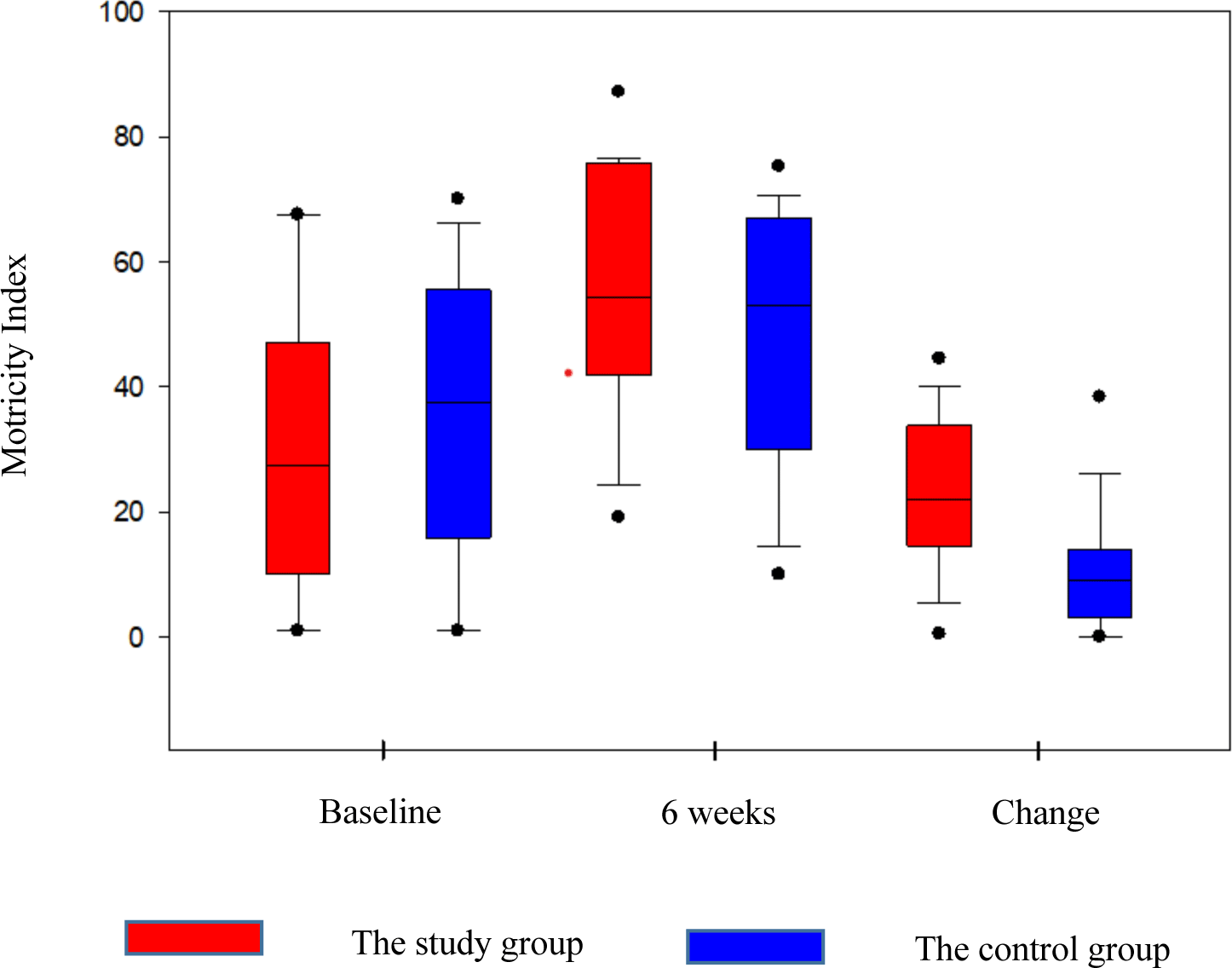
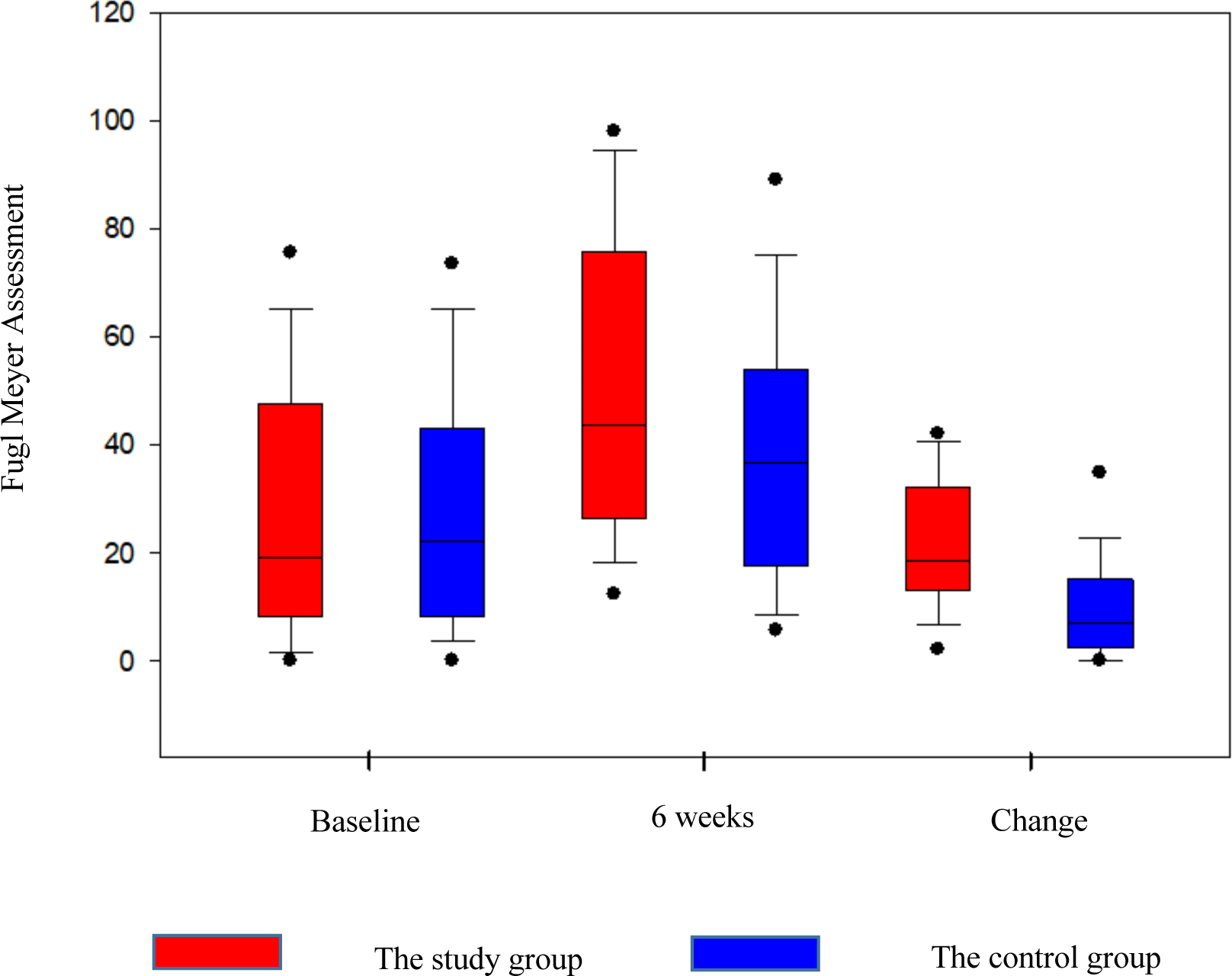
4. DISCUSSION
Auricular acupuncture is an acupuncture method with a long history of TCM to stimulate acupuncture points on the ear for disease prevention and treatment with simple operation and quick effect. Acupuncture is used in stroke treatment to treat the brain, internal organs, and body symptoms. Symptoms related to the brain include depression, insomnia, swallowing disorders, headaches, and cognitive dysfunction; visceral symptoms such as belching, hiccups, urinary incontinence, arrhythmias, and respiratory failure; physical symptoms include limb weakness, shoulder-arm syndrome, and thumb numbness. However, the number of available clinical studies is still small, the type of clinical reports is not diverse, there is a lack of controlled trials, the observed indicators of therapeutic efficacy are not uniform enough, and the quality of the literature is limited. The reference data is low, so more basic and high-quality clinical studies are needed to prove the effectiveness of auricular acupuncture in stroke patients [16], [24]. Our study aims to elucidate the effectiveness of auricular acupuncture combined with electro-acupuncture and physiotherapy exercise in motor rehabilitation after stroke compared with the conventional regimen in hospitals that combines electro-acupuncture and physiotherapy exercise. Auricular acupuncture (AA) can communicate with other parts of the body through the nerves in the ear to increase blood perfusion in the ischemic area and promote the recovery of damaged brain cells. One of the mechanisms of AA helps to support the rehabilitation process after stroke by enhancing neuroplasticity through adrenergic and noradrenergic systems, activating neural networks in the brain stem to regulate motor pathways in the upper spinal cord [11], [15], [25]. Studies suggest that the relationship between auricular acupuncture and other parts of the body is due to the X nerve and the autonomic nervous system [16]. Because of the diversity of nerve distribution in the external ear, this area of auricle can be connected with the brain, spinal cord, and autonomic nervous system (the sympathetic is mainly associated through the superficial cervical plexus, and the glossopharyngeal nerve parasympathetic is primarily connected with the parasympathetic nerves). X nerve, through the auricular branch of the vagus nerve (ABVN), transmits afferent signals into nucleus of the solitary tract. Depending on the complex connections between the brain and viscera, ABVN branch stimulation may modulate the autonomic nervous system by increasing parasympathetic activity [16]. According to a study by Dan Miao, results show that Auricular Intradermal Acupuncture (AIA) adds considerable value to acupuncture and motor rehabilitation in patients (stage III Brunnstrom) undergoing stroke rehabilitation. In particular, AIA can improve stroke rehabilitation patients’ extensor synergy movement and acceleration [15].
Regarding the study population’s characteristics, the study group’s mean age was 61.80 ± 11.39, and the control group was 60.38 ± 12.36. This result is similar to Dan Miao’s study, with the mean age of the study group was 62.23 ± 13.44 and the control group being 65.22 ± 11.14 [15], to that of Dandong Wu’s study with the study group’s mean age was 64.50 ± 9.97 and the control group is 61.82 ± 10.63 [25]. The sex distribution in our study is a higher proportion of males than females in both the control and the study group (the male/female ratio is 1.33/1); this result is similar to the study of Dan Miao (male/female ratio is 1.62/1) [15]. This result is also consistent with the distribution of age and sex in stroke pathology, in which the average age of Vietnamese people having a stroke is about 65 years old; The rate of men having a stroke is more than that of women, 1.5 times higher than that of women [26]. The mean stroke time in the study group was 34.88 ± 29.31, and the control group was 28.64 ± 26.92. This result is similar to the study of Dan dong Wu, whereby the time of stroke (duration of onset) of the study group was 36.30 ± 9.23, and the control group was 35.55 ± 6.47 [25]. The two study groups were identical in terms of background information (age, gender), vital signs, and body index (pulse, temperature, respiration, blood pressure, BMI), which is a premise for the comparison of the therapeutic effects of the two groups are objective and reliable.
Regarding the acupressure formula, our study selected six acupoints based on the principle of choosing auricular acupuncture points, in which four acupoints of SF4 (Shoulder), SF1 (Finger), AH5 (Hip), AH4 (Knee) were selected according to the principle of choosing auricular acupuncture points corresponding to the diseased area - is the most basic and popular method for selecting acupoints. Specifically, SF4 (Shoulder) and SF1 (Finger) were used to restore upper limb movement; AH5 (Hip) and AH4 (Knee) were used to restore lower limb movement; AT4 (Subcortex) and AH6 (Sympathetic) were selected according to the principle of choosing acupoints according to the pathophysiology of modern medicine. In particular, the AT4 (Subcortex) acupoint helps to recuperate subcortical brain function and relieve mental tension [27], [28]. The AH6 (Sympathetic) acupoint treats dysfunctions of the autonomic nervous system and restores movement; Besides, the mechanism of action of AA on stroke is related to the mechanism of regulation of the autonomic nervous system involving stimulating ABVN [11], [16]. Research by Dan Miao and colleagues in a 2019 meta-analysis of 35 studies related to auricular acupuncture after stroke summarizing the selected acupoints for treatment after stroke, the results show that to treat symptoms of limb movement disorder after stroke acupoints were selected mainly in the fossa of the helix (area of acupoints in hand), antihelix (location of acupoints in the leg), antitragus (site of the Subcortex acupoint), in which the Shoulder and Finger acupoints are used most often. According to neuroanatomy, the antitragus and fossa of the helix are innervated by the great ear nerve and the X nerve, which is also consistent with the mechanism of auricular acupuncture (excitation of the X nerve) in stroke recovery [24]. Similarly, Wang Song Lin’s study to evaluate the effectiveness of auricular acupuncture combined with physiotherapy in stroke rehabilitation patients also used acupoints AT4 (Subcortex), SF4 (Shoulder), AH5 (Hip), and AH4 (Knee) [29]. Dan Miao’s study and evaluation of the effectiveness of Auricular intradermal acupuncture (AIA) combined with routine acupuncture in stroke rehabilitation patients also chose SF4 (Shoulder) and SF1 (Finger) acupoints corresponding to the upper limb area, choose AH5 (Hip) and AH4 (Knee) acupoints to affect the lower extremity respectively [15]. Liu Y’s study also used AT4 (Subcortex) acupoint to examine the efficacy and safety of AA in supporting motor rehabilitation for ischemic stroke patients with upper extremity movement disorders [27].
Regarding the effectiveness of the study group’s movement recovery compared to the control group, in our study, the average FMA score of the study group in the pre-study period was 27.86 ± 24.18, in which FMA - UE was 16.31 ± 17.38, FMA – LE was 11.55 ± 8.21; In the control group, the average FMA score was 28.50 ± 23.02, FMA - UE was 15.63 ± 15.91, FMA - LE was 12.88 ± 8.16. In the pre-study period, the difference between the two groups was insignificant (p>0.05). This result is similar to Dandong Wu’s study, with the mean FMA - UE score of 17.50 ± 4.91 in the study group and 16.82 ± 3.89 in the control group, the two groups have an insignificant difference (p>0.05) [25]. In our study, after six weeks of treatment, the FMA of the study group increased to 49.84 ± 28.37 (FMA mean change from baseline 21.97 ± 12.75), and that of the control group was 38.72 ± 24.38 (FMA mean change from baseline 10.22 ± 10.26), the two groups have an insignificant difference; in particular, study group recovered better than the other. Compared with Wang Song Lin’s study, the FMA of the study group after treatment was 61.37 ± 19.16 (FMA mean change from baseline 47.25 ± 10.45), of the control group was 43.19 ± 11.79 (FMA mean change from baseline 27.72 ± 6.33) then the change in FMA score (before and after treatment) is more significant than our study [29]. The post-treatment FMA-UE score in our study was 29.41 ± 21.16 in the study group and 21.81 ± 17.08 in the control group, besides, FMA - UE mean change from baseline 13.09 ± 9.50 in the study group and 6.19 ± 7.44 in the control group; this difference is statistically significant (p<0.001). Compared with Dandong Wu’s study, the post-treatment FMA-UE score in the study group was 24.4 ± 4.62. The control group was 20.0 ± 3.58, the FMA - UE mean change from baseline was 6.90 ± 1.85 in the study group and 3.18 ± 1.17 in the control group; the change in FMA-UE score (before and after treatment) is lower than our study [25]. This difference may be because Wang Song Lin’s study lasted eight weeks, while that of Dandong Wu’s study lasted two weeks, so Wang Song Lin’s recovery efficiency may be higher, and Dandong Wu’s is lower than that of our 6-week study. This difference suggested that a longer duration of treatment with repeated activities can better support stroke recovery. Neuroplasticity means the brain is flexible and has the ability to adapt, repair, and reorganize after injury [30]. Rehabilitation involves these principles that require task repetition and task-specific practice to be practical. According to studies, neurological recovery peaks within the first three months of a stroke, while rehabilitation can continue for a longer period (six months to three years after a stroke) [31], which may suggest the more extended period of using acupuncture methods are used, the more beneficial they can be in stroke recovery.
Although previous research has shown that auricular acupuncture can improve stroke sequelae, differences between the previous studies and our study persist: (a) We used auricular acupuncture combined with electro-acupuncture and standard physiotherapy for patients with motor dysfunction after stroke. This difference shows the complementary effect between auricular acupuncture with the combination of electro-acupuncture and rehabilitation (b) Earlier studies used different techniques of auricular acupuncture, such as direct needle stimulation [29] or techniques similar to auricular acupuncture, such as Auricular Intradermal Acupuncture [15] or Transcutaneous Auricular Vagus Nerve [25]; while our study used press needles. This technique can help the treating doctor easily install and fix them on the external ear, the needle retention time is 3-5 days to help the patient save time, and there is no need to prick the needle daily. (c) Our study used the sham acupuncture technique in combination with conventional treatment in the control group, while other studies used only conventional therapy in the control group, so the patients participating in these studies were not blinded, while the sham-auricular technique in our study helped to blind the study, participants did not know which group they belonged to, increasing the reliability of the study.
While the data are encouraging, our study also has limitations. First, our study only intervened in the early recovery period of ischemic stroke, and the sample size was small, so the results cannot be generalizable to the stroke population. Therefore, further studies should be conducted with a larger number of patients in the acute and subacute phases of both hemorrhagic and ischemic stroke. Second, we only evaluated the results after six weeks of the intervention and did not do a longer follow-up, so we are not sure how long the effects of the treatment will last beyond six weeks.
Thus, the research results can contribute to applying Traditional medicine in the care and treatment of post-stroke patients, specifically, the application of auricular acupuncture combined with electro-acupuncture and physiotherapy in motor rehabilitation of post-stroke patients. Our study also shows that FMA, MI, and BI can be valuable tools to support the comprehensive assessment according to the ICF model in post-stroke patients; this is evidence for applying these scales in Vietnamese traditional medicine research. The study partly elucidates the mechanism of auricular acupuncture in both principles of traditional medicine (selecting acupoints correspondent to the diseased area) and modern medicine (affecting the autonomic nervous system) on post-stroke rehabilitation.
Conclusion
Results from this study have demonstrated that auricular acupuncture appears to be beneficial for motor function recovery in ischemic stroke patients. This therapy may add significant value to motor rehabilitation (with conventional acupuncture and physiotherapy exercise). Future RCT studies with larger sample sizes should be conducted to confirm the efficacy of auricular acupuncture on the chronic and acute phases of stroke.

